Pollution Characteristics and Risk Assessments of Mercury in Jiutai, a County Region Thriving on Coal Mining in Northeastern China
Abstract
:1. Introduction
- Atmospheric mercury from fossil fuel combustion eventually returns to the soil through wet and dry deposition—e.g., coal-fired thermal power plants and coal-fired power for industrial mercury release, oil smelting, and automobile emissions.
- The raw materials of non-ferrous metal smelting and the cement industry contain mercury, which is activated in the production process so that it migrates and transforms, causing mercury pollution to the air, water, and soil.
- The production and use of items containing mercury such as fluorescent lamps, dental amalgams, thermometers, pressure gauges, and electronic products.
- Emissions caused by waste treatment and incineration processes: various waste treatment facilities and landfills also produce mercury pollution.
2. Materials and Methods
2.1. Study Area
2.2. Sampling and Analysis Processes
2.3. Ecological Risk Assessment Processes
2.3.1. Geo-Accumulation Index (Igeo)
2.3.2. Potential Ecological Risk Index (Er)
2.4. Health Risk Assessments
2.4.1. Exposure Assessments
2.4.2. Non-Carcinogenic Risk Assessments
3. Results
3.1. Mercury Concentrations in the Environment
3.1.1. Mercury in Surface Soils
3.1.2. Atmospheric Mercury in Urban Areas
3.2. Risk Assessment
3.2.1. Ecological Risk Assessment of Soil Mercury Pollution
3.2.2. Health Risk Assessment of Soil Mercury
4. Discussion
4.1. Mercury Distribution in Urban Environment
4.1.1. Spatial Distribution Characteristics of Soil Mercury Concentration
4.1.2. Spatial Distribution Characteristics of Atmospheric Mercury Concentration
4.1.3. Relationship between Soil Mercury Concentration and Atmospheric Mercury Concentration
4.1.4. Relationship between Soil Mercury Concentration and Wind Direction
4.1.5. Influence of Mining Area on Mercury Content in Urban Soil
4.2. Risk Assessment of Soil Mercury Pollution in Jiutai District
4.2.1. Ecological Risk Assessments of the Soil Mercury Pollution
4.2.2. Assessment of the Potential Health Risks of Soil Mercury Contamination
5. Conclusions
Author Contributions
Funding
Institutional Review Board Statement
Informed Consent Statement
Data Availability Statement
Acknowledgments
Conflicts of Interest
References
- Driscoll, C.T.; Mason, R.; Chan, H.M.; Jacob, D.J.; Pirrone, N. Mercury as a Global Pollutant: Sources, Pathways, and Effects. Environ. Sci. Technol. 2013, 47, 4967–4983. [Google Scholar] [CrossRef] [PubMed]
- Wang, J.; Ma, L.Q.; Letcher, R.; Bradford, S.A.; Feng, X.; Rinklebe, J. Biogeochemical cycle of mercury and controlling technologies: Publications in critical reviews in environmental science & technology in the period of 2017–2021. Crit. Rev. Environ. Sci. Technol. 2022, 1–6. [Google Scholar] [CrossRef]
- Feng, X.; Chen, J.; Fu, X.; Hu, H.; Li, P.; Qiu, G.; Yan, H.; Yin, R.; Zhang, H.; Zhu, W. Progresses on Environmental Geochemistry of Mercury. Bull. Mineral. Petrol. Geochem. 2013, 32, 503–530. (In Chinese) [Google Scholar]
- Osipova, N.A.; Tkacheva, E.V.; Arbuzov, S.I.; Yazikov, E.G.; Matveenko, I.A. Mercury in Coals and Soils from Coal-Mining Regions. Solid Fuel Chem. 2019, 53, 411–417. [Google Scholar] [CrossRef]
- Wu, Q.; Wang, S.; Li, G.; Liang, S.; Lin, C.-J.; Wang, Y.; Cai, S.; Liu, K.; Hao, J. Temporal Trend and Spatial Distribution of Speciated Atmospheric Mercury Emissions in China During 1978–2014. Environ. Sci. Technol. 2016, 50, 13428–13435. [Google Scholar] [CrossRef] [PubMed]
- Tian, H.Z.; Lu, L.; Hao, J.M.; Gao, J.J.; Cheng, K.; Liu, K.Y.; Qiu, P.P.; Zhu, C.Y. A Review of Key Hazardous Trace Elements in Chinese Coals: Abundance, Occurrence, Behavior during Coal Combustion and Their Environmental Impacts. Energy Fuels 2013, 27, 601–614. [Google Scholar] [CrossRef]
- Yudovich, Y.E.; Ketris, M. Mercury in coal: A review: Part 1. Geochemistry. Int. J. Coal Geol. 2005, 62, 107–134. [Google Scholar] [CrossRef]
- Nriagu, J.O.; Pacyna, J.M. Quantitative assessment of worldwide contamination of air, water and soils by trace metals. Nature 1988, 333, 134–139. [Google Scholar] [CrossRef]
- Feng, X.; Hong, Y. Modes of occurrence of mercury in coals from Guizhou, People’s Republic of China. Fuel 1999, 78, 1181–1188. [Google Scholar] [CrossRef]
- Li, J.; Wang, J. Comprehensive utilization and environmental risks of coal gangue: A review. J. Clean. Prod. 2019, 239, 117946. [Google Scholar] [CrossRef]
- Jilin Provincial Bureau of Statistics. Jilin Statistical Yearbook; Changchun Audio and Video Electronic Publishing House: Changchun, China, 2021.
- Song, W.; He, T. Environmental effects of mercury in coal mine spoils in Panxian of Guizhou Province. Chin. J. Ecol. 2009, 28, 1589–1593. (In Chinese) [Google Scholar] [CrossRef]
- Wang, X.; Tang, Y.; Ma, T.; Chen, Y. Research progress onmigration and transformation behavior of hazardous mineral matter in coals during coal combustion. Coal Sci. Technol. 2021, 49, 207–219. (In Chinese) [Google Scholar]
- Miller, C.L.; Watson, D.B.; Lester, B.P.; Lowe, K.A.; Pierce, E.M.; Liang, L. Characterization of soils from an industrial complex contaminated with elemental mercury. Environ. Res. 2013, 125, 20–29. [Google Scholar] [CrossRef] [PubMed]
- Ouyang, D.; Liu, K.; Wu, Q.; Wang, S.; Tang, Y.; Li, Z.; Liu, T.; Han, L.; Cui, Y.; Li, G.; et al. Effect of the Coal Preparation Process on Mercury Flows and Emissions in Coal Combustion Systems. Environ. Sci. Technol. 2021, 55, 13687–13696. [Google Scholar] [CrossRef]
- Li, R.; Yuan, Y.; Li, C.; Sun, W.; Yang, M.; Wang, X. Environmental Health and Ecological Risk Assessment of Soil Heavy Metal Pollution in the Coastal Cities of Estuarine Bay—A Case Study of Hangzhou Bay, China. Toxics 2020, 8, 75. [Google Scholar] [CrossRef]
- Raj, D.; Kumar, A.; Maiti, S.K. Evaluation of toxic metal(loid)s concentration in soils around an open-cast coal mine (Eastern India). Environ. Earth Sci. 2019, 78, 645. [Google Scholar] [CrossRef]
- Zhang, L.; Wong, M.H. Environmental mercury contamination in China: Sources and impacts. Environ. Int. 2007, 33, 108–121. [Google Scholar] [CrossRef]
- Fang, F.; Wang, Q.; Li, J. Urban environmental mercury in Changchun, a metropolitan city in Northeastern China: Source, cycle, and fate. Sci. Total Environ. 2004, 330, 159–170. [Google Scholar] [CrossRef]
- Wang, Z.; Wang, L.; Xiao, T.; Yu, T.; Li, X.; Tang, Z.; Zhang, G. Pollution Characteristics and Risk Assessments of Mercury in the Soil of the Main Urban Regions in a Typical Chinese Industrial City: Changchun. Pol. J. Environ. Stud. 2021, 30, 3829–3841. [Google Scholar] [CrossRef]
- Rodrigues, S.; Pereira, M.; Duarte, A.; Ajmone-Marsan, F.; Davidson, C.; Grčman, H.; Hossack, I.; Hursthouse, A.; Ljung, K.; Martini, C.; et al. Mercury in urban soils: A comparison of local spatial variability in six European cities. Sci. Total Environ. 2006, 368, 926–936. [Google Scholar] [CrossRef]
- Fei, X.; Lou, Z.; Xiao, R.; Ren, Z.; Lv, X. Contamination assessment and source apportionment of heavy metals in agricultural soil through the synthesis of PMF and GeogDetector models. Sci. Total Environ. 2020, 747, 141293. [Google Scholar] [CrossRef] [PubMed]
- Bi, X.; Zhang, M.; Wu, Y.; Fu, Z.; Sun, G.; Shang, L.; Li, Z.; Wang, P. Distribution patterns and sources of heavy metals in soils from an industry undeveloped city in Southern China. Ecotoxicol. Environ. Saf. 2020, 205, 111115. [Google Scholar] [CrossRef] [PubMed]
- Khan, S.; Munir, S.; Sajjad, M.; Li, G. Urban park soil contamination by potentially harmful elements and human health risk in Peshawar City, Khyber Pakhtunkhwa, Pakistan. J. Geochem. Explor. 2016, 165, 102–110. [Google Scholar] [CrossRef]
- Liu, W.; Li, Y.; Li, J.; Tang, Z. Distribution and temporal trend of heavy metals in soils from typical areas in a coal-mining city. Environ. Pollut. Control. 2021, 43, 984–989. (In Chinese) [Google Scholar]
- Wu, X.; Huang, X.; Quan, W.; Hu, J.; Qin, F.; Tang, F. Chemical Forms and Risk Assessment of Heavy Metals in Soils and Selected Hypertolerant Plants around a Coal Mining Area in Western Guizhou Province. Bull. Soil Water Conserv. 2018, 38, 313–321. (In Chinese) [Google Scholar]
- Liang, J.; Feng, C.; Zeng, G.; Gao, X.; Zhong, M.; Li, X.; Li, X.; He, X.; Fang, Y. Spatial distribution and source identification of heavy metals in surface soils in a typical coal mine city, Lianyuan, China. Environ. Pollut. 2017, 225, 681–690. [Google Scholar] [CrossRef]
- Pan, L.; Ma, J.; Hu, Y.; Su, B.; Fang, G.; Wang, Y.; Wang, Z.; Wang, L.; Xiang, B. Assessments of levels, potential ecological risk, and human health risk of heavy metals in the soils from a typical county in Shanxi Province, China. Environ. Sci. Pollut. Res. 2016, 23, 19330–19340. [Google Scholar] [CrossRef]
- Loska, K.; Wiechuła, D.; Korus, I. Metal contamination of farming soils affected by industry. Environ. Int. 2004, 30, 159–165. [Google Scholar] [CrossRef]
- Doležalová Weissmannová, H.; Mihočová, S.; Chovanec, P.; Pavlovský, J. Potential ecological risk and human health risk assessment of heavy metal pollution in industrial affected soils by coal mining and metallurgy in Ostrava, Czech Republic. Int. J. Environ. Res. Public Health 2019, 16, 4495. [Google Scholar] [CrossRef] [Green Version]
- Yin, W.; Lu, Y.; Li, J.-H.; Chen, C.-X.; Zhang, C.; Dong, F. Distribution Characteristics and Pollution Assessment of Mercury in Urban Soils of Guangzhou. J. Soil Sci. 2009, 40, 1185–1188. (In Chinese) [Google Scholar]
- Yao, Y.; Fang, F.; Wu, J.; Zhu, Z.; Lin, Y.; Zhang, D.; Zhu, H. Concentrations and pollution assessment of mercury in surfaces dust at urban streets and elementary school campuses of Huainan City. Environ. Sci. Technol. 2017, 37, 844–852. (In Chinese) [Google Scholar]
- Christophoridis, C.; Evgenakis, E.; Bourliva, A.; Papadopoulou, L.; Fytianos, K. Concentration, fractionation, and ecological risk assessment of heavy metals and phosphorus in surface sediments from lakes in N. Greece. Environ. Geochem. Heal. 2020, 42, 2747–2769. [Google Scholar] [CrossRef] [PubMed]
- Liu, K.; Li, C.; Tang, S.; Shang, G.; Yu, F.; Li, Y. Heavy metal concentration, potential ecological risk assessment and enzyme activity in soils affected by a lead-zinc tailing spill in Guangxi, China. Chemosphere 2020, 251, 126415. [Google Scholar] [CrossRef] [PubMed]
- OSWER 9355; 4-24 Supplemental Guidance for Developing Soil Screening Levels for Superfund Sites. Environmental Protection Agency: Washington, DC, USA, 2001.
- US EPA. Risk-Based Concentration Table; Environmental Protection Agency: Philadelphia, PA, USA, 2000.
- Xu, J.; Zhang, B.; Wang, Z.; Guo, Y.; Song, K. Chromium Accumulation in Soils for Different Land Uses and Spatial Distribution of Chromium in Jiutai City of Jilin Province. J. Soil Water Conserv. 2006, 20, 36–39. (In Chinese) [Google Scholar]
- Xu, Z.; Liu, W.; Ding, R.; Wang, J. Perlite in Yingcheng Coal Mine, Jiutai: Characteristics, Formation and Reservoir Significance, Journal of Jilin University. Earth Sci. Ed. 2007, 37, 1139–1145. (In Chinese) [Google Scholar]
- Zhu, J.; Li, G.; You, B. Application of overlying strata damage theory in evaluation on foundation stability: Taking Yingcheng coal mine in Jiutai of Jilin as an example. World Geol. 2012, 31, 584–588. (In Chinese) [Google Scholar]
- Changchun Jiutai District Chorography Compilation Committee. Jiutai Yearbook; Fang Zhi Publishing House: Changchun, China, 2021. [Google Scholar]
- Sabouhi, M.; Ali-Taleshi, M.S.; Bourliva, A.; Nejadkoorki, F.; Squizzato, S. Insights into the anthropogenic load and occupational health risk of heavy metals in floor dust of selected workplaces in an industrial city of Iran. Sci. Total Environ. 2020, 744, 140762. [Google Scholar] [CrossRef]
- Meng, X.X.; Li, S.Z. Background Value of Soil Elements in Jilin Province; Science Press: Beijing, China, 1995; p. 64. (In Chinese) [Google Scholar]
- Maanan, M.; Saddik, M.; Maanan, M.; Chaibi, M.; Assobhei, O.; Zourarah, B. Environmental and ecological risk assessment of heavy metals in sediments of Nador lagoon, Morocco. Ecol. Indic. 2015, 48, 616–626. [Google Scholar] [CrossRef]
- Xu, Z.; Ni, S.; Tuo, X.; Zhang, C. Calculation of Heavy Metals’ Toxicity Coefficient in the Evaluation of Potential Ecological Risk Index. Environ. Sci. Technol. 2008, 31, 112–115. (In Chinese) [Google Scholar]
- Means, B. Risk-Assessment Guidance for Superfund Volume 1: Human Health Evaluation Manual (Part A); EPA-540/1-89/002; Environmental Protection Agency: Washington, DC, USA, 1989.
- Ying, L.; Shaogang, L.; Xiaoyang, C. Assessment of heavy metal pollution and human health risk in urban soils of a coal mining city in East China. Hum. Ecol. Risk Assess. Int. J. 2016, 22, 1359–1374. [Google Scholar] [CrossRef]
- Du, Y.; Gao, B.; Zhou, H.; Ju, X.; Hao, H.; Yin, S. Health Risk Assessment of Heavy Metals in Road Dusts in Urban Parks of Beijing, China. Procedia Environ. Sci. 2013, 18, 299–309. [Google Scholar] [CrossRef] [Green Version]
- Vilavert, L.; Nadal, M.; Schuhmacher, M.; Domingo, J.L. Concentrations of Metals in Soils in the Neighborhood of a Hazardous Waste Incinerator: Assessment of the Temporal Trends. Biol. Trace Element Res. 2012, 149, 435–442. [Google Scholar] [CrossRef] [PubMed]
- Hassett-Sipple, B.; Swartout, J.; Mahaffey, K.R.; Rice, G.E.; Schoeny, R. Mercury Study Report to Congress: Health Effects of Mercury and Mercury Com-Pounds; US EPA EPA-452/R-97-007; Environmental Protection Agency: Washington, DC, USA, 1997.
- US EPA. Supplemental Guidance for Developing Soil Screeninglevels for Superfund Sites; Offlice of Soild Waste and Emergency Response: Washington, DC, USA, 2001; pp. 4–24.
- Wang, S.; Luo, K.; Wang, X.; Sun, Y. Estimate of sulfur, arsenic, mercury, fluorine emissions due to spontaneous combustion of coal gangue: An important part of Chinese emission inventories. Environ. Pollut. 2016, 209, 107–113. [Google Scholar] [CrossRef] [PubMed]
- Liang, Y.; Liang, H.; Zhu, S. Mercury emission from spontaneously ignited coal gangue hill in Wuda coalfield, Inner Mongolia, China. Fuel 2016, 182, 525–530. [Google Scholar] [CrossRef]
- Wei, Q.; Chen, W.; Jin, L. Health risk assessment and source analysis of heavy metal elements in PM2.5 in Zaozhuang city. China Powder Sci. Technol. 2020, 26, 69–78. (In Chinese) [Google Scholar]
- Yang, Y.; Liu, S.; Yang, Y.; Li, L.; Liu, S.; Kang, Y.; Fei, X.; Gao, Y.; Gao, B. Heavy metals in peri-urban soil of Huangshi: Their distribution, risk assessment and source identification. Geophys. Geochem. Explor. 2021, 45, 1147–1156. (In Chinese) [Google Scholar]
- Zheng, L.; Liu, G.; Wang, L.; Chou, C.-L. Composition and quality of coals in the Huaibei Coalfield, Anhui, China. J. Geochem. Explor. 2008, 97, 59–68. [Google Scholar] [CrossRef]
- Tian, L. The status and evaluation of environment in the Xiaoyi city of Shanxi province. Shanxi Archit. 2011, 37, 179–180. (In Chinese) [Google Scholar]
- Xie, Y.; Tang, W. Investigation & Assessment for Heavy metal in Soil of Fushun Typical Areas. Environ. Sci. Manag. 2009, 34, 38–40+78. (In Chinese) [Google Scholar]
- Kim, K.-H.; Kim, M.-Y. The effects of anthropogenic sources on temporal distribution characteristics of total gaseous mercury in Korea. Atmos. Environ. 2000, 34, 3337–3347. [Google Scholar] [CrossRef]
- Leonard, T.L.; Taylor, G.E., Jr.; Gustin, M.S.; Fernandez, G.C. Mercury and plants in contaminated soils: 1. Uptake, partitioning, and emission to the atmosphere. Environ. Toxicol. Chem. 1998, 17, 2063–2071. [Google Scholar] [CrossRef]
- Lei, L.; Yu, D.; Chen, Y.; Song, W.; Liang, D.; Wang, Z. Spatial distribution and sources of heavy metals in soils of Jinghui Irrigated Area of Shaanxi, China. Trans. Chin. Soc. Agric. Eng. 2014, 30, 88–96. (In Chinese) [Google Scholar]
- Lin, C.-J.; Pehkonen, S. The chemistry of atmospheric mercury: A review. Atmos. Environ. 1999, 33, 2067–2079. [Google Scholar] [CrossRef]
- Manta, D.S.; Angelone, M.; Bellanca, A.; Neri, R.; Sprovieri, M. Heavy metals in urban soils: A case study from the city of Palermo (Sicily), Italy. Sci. Total Environ. 2002, 300, 229–243. [Google Scholar] [CrossRef] [PubMed]
- Li, K.; Gu, Y.; Li, M.; Zhao, L.; Ding, J.; Lun, Z.; Tian, W. Spatial analysis, source identification and risk assessment of heavy metals in a coal mining area in Henan, Central China. Int. Biodeterior. Biodegrad. 2018, 128, 148–154. [Google Scholar] [CrossRef]
- Xu, Y.; Lu, F.; Dong, L.; Yang, J.; Nai, C.; Liu, Y. Human health effects of heavy metals around an incineration plant through multi-media exposure. Acta Sci. Circumst. 2016, 36, 3464–3471. (In Chinese) [Google Scholar]
- Liu, X.; Zheng, L.; Chen, X.; Yang, T.; Chen, Y.; Cheng, H. Study on the heavy metal pollution characteristics of agricultural soiland their accumulation characteristics in wheat in Panji mining area, Huainan. Environ. Pollut. Prevention. 2019, 41, 959–964. (In Chinese) [Google Scholar]

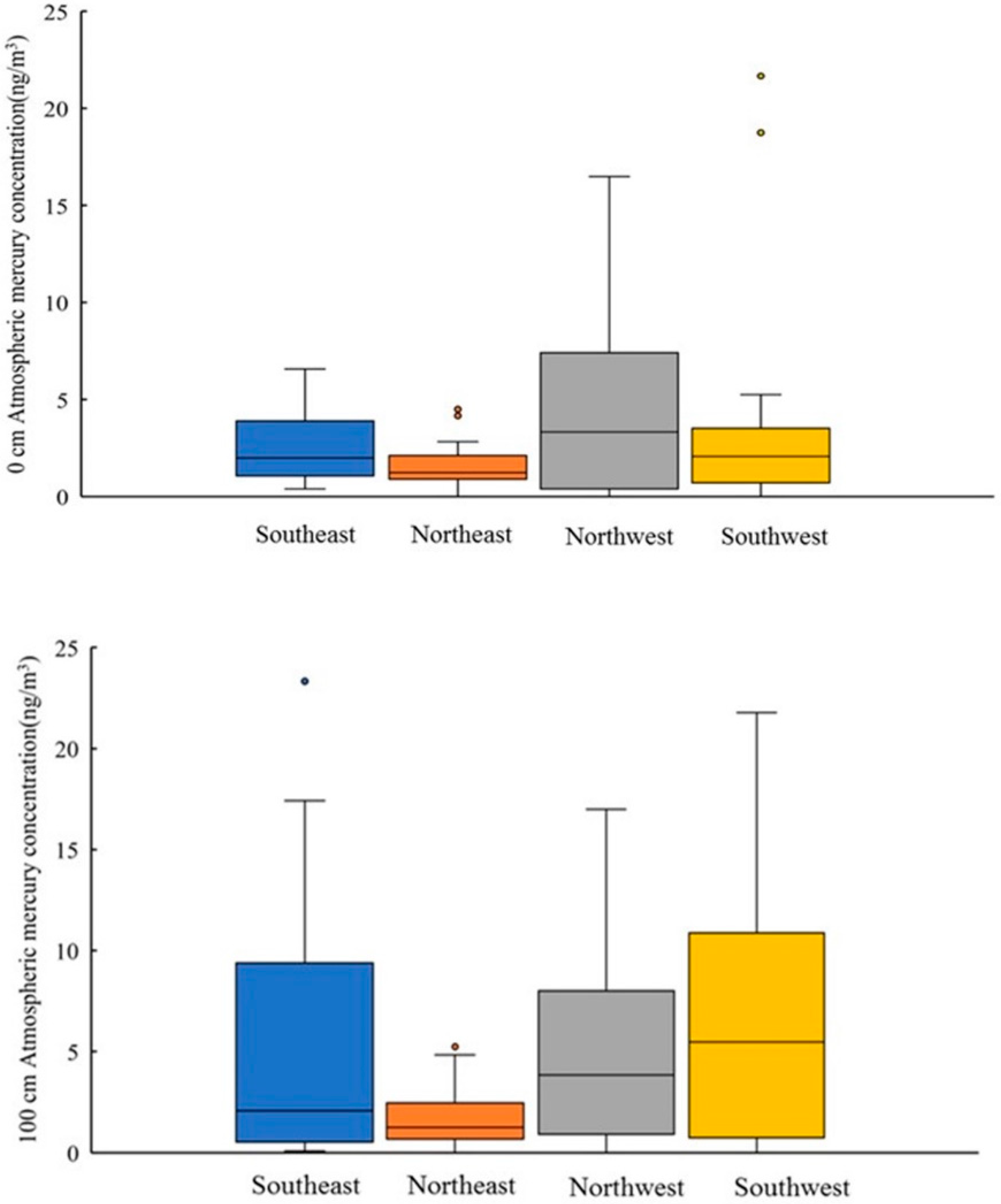
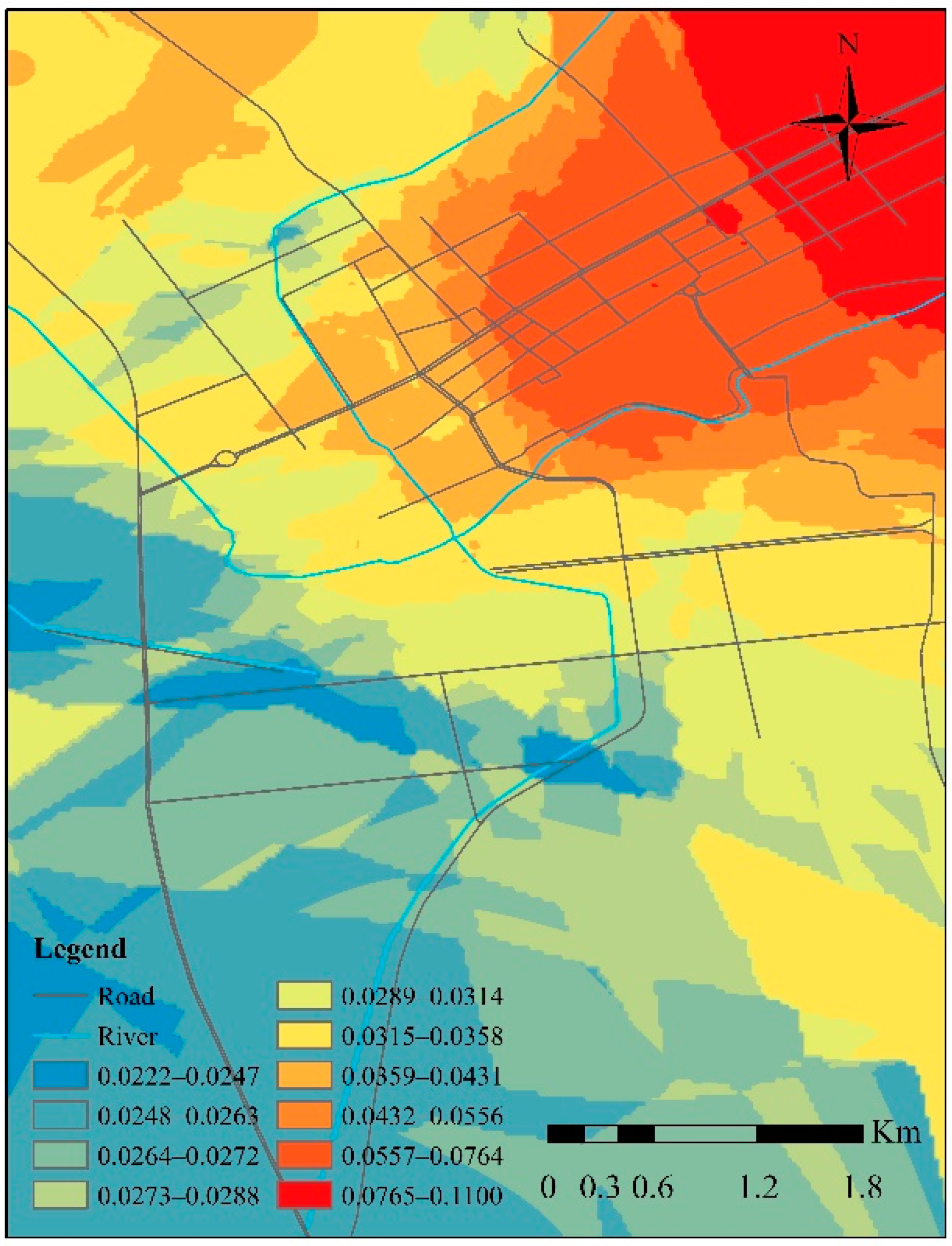
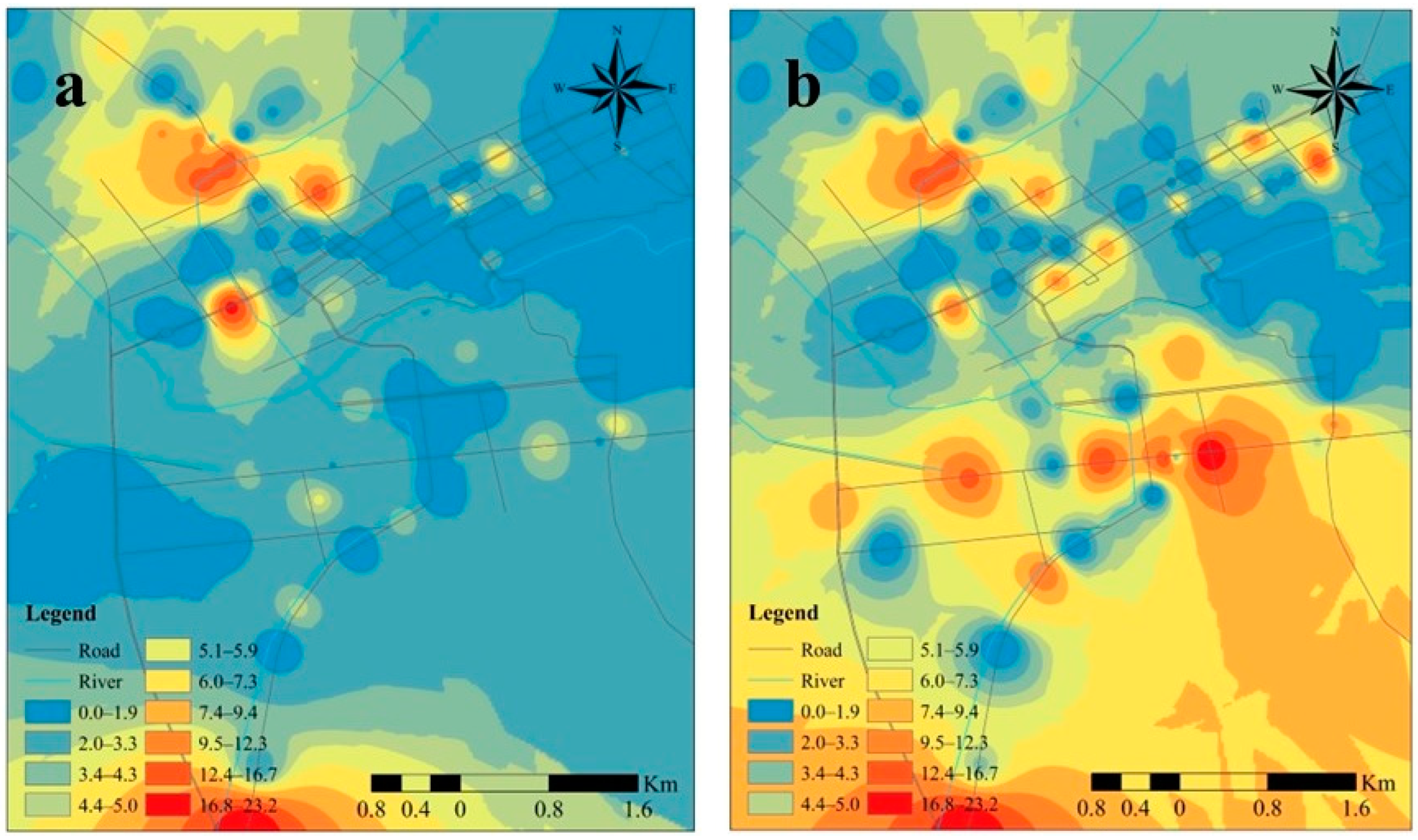
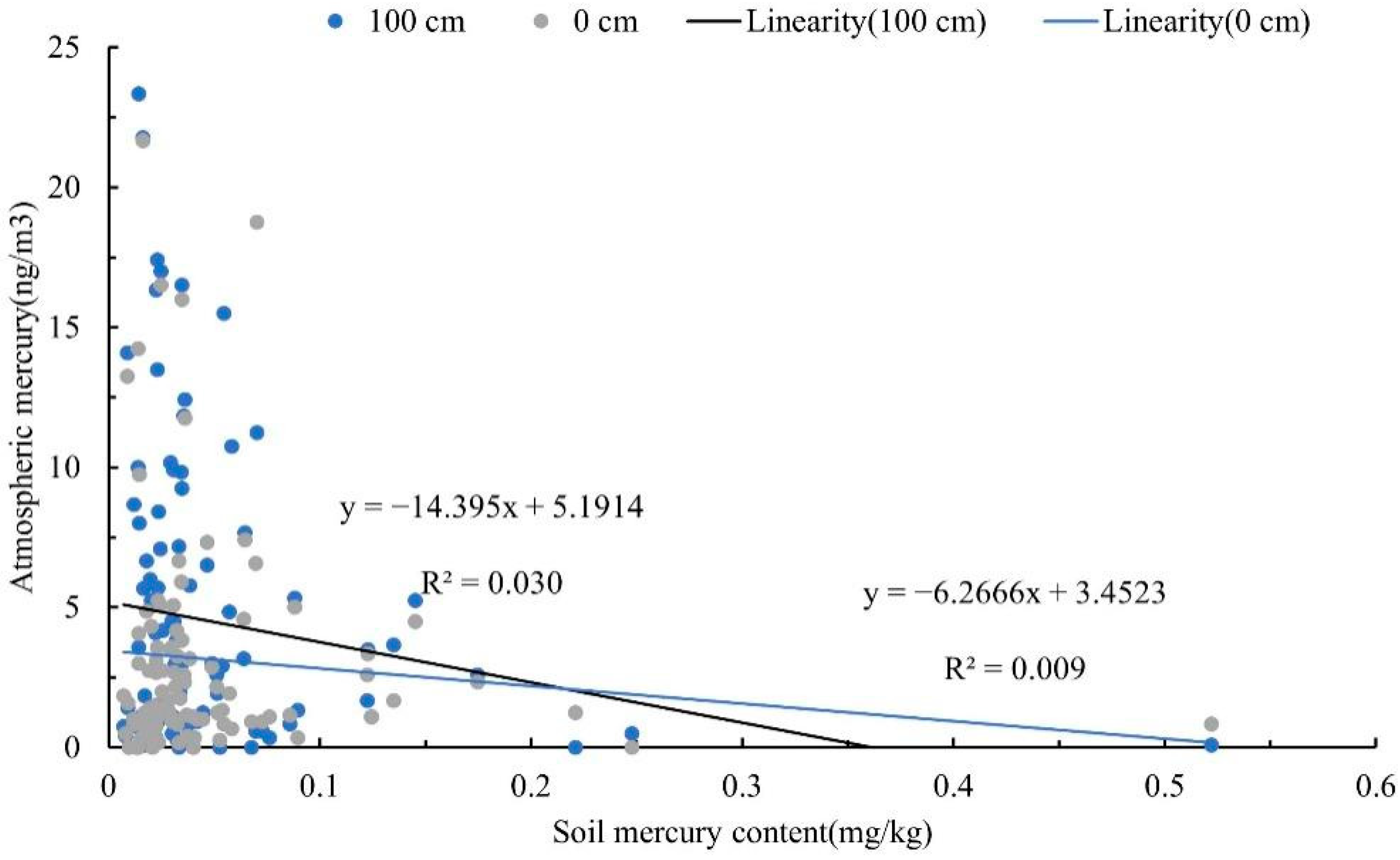
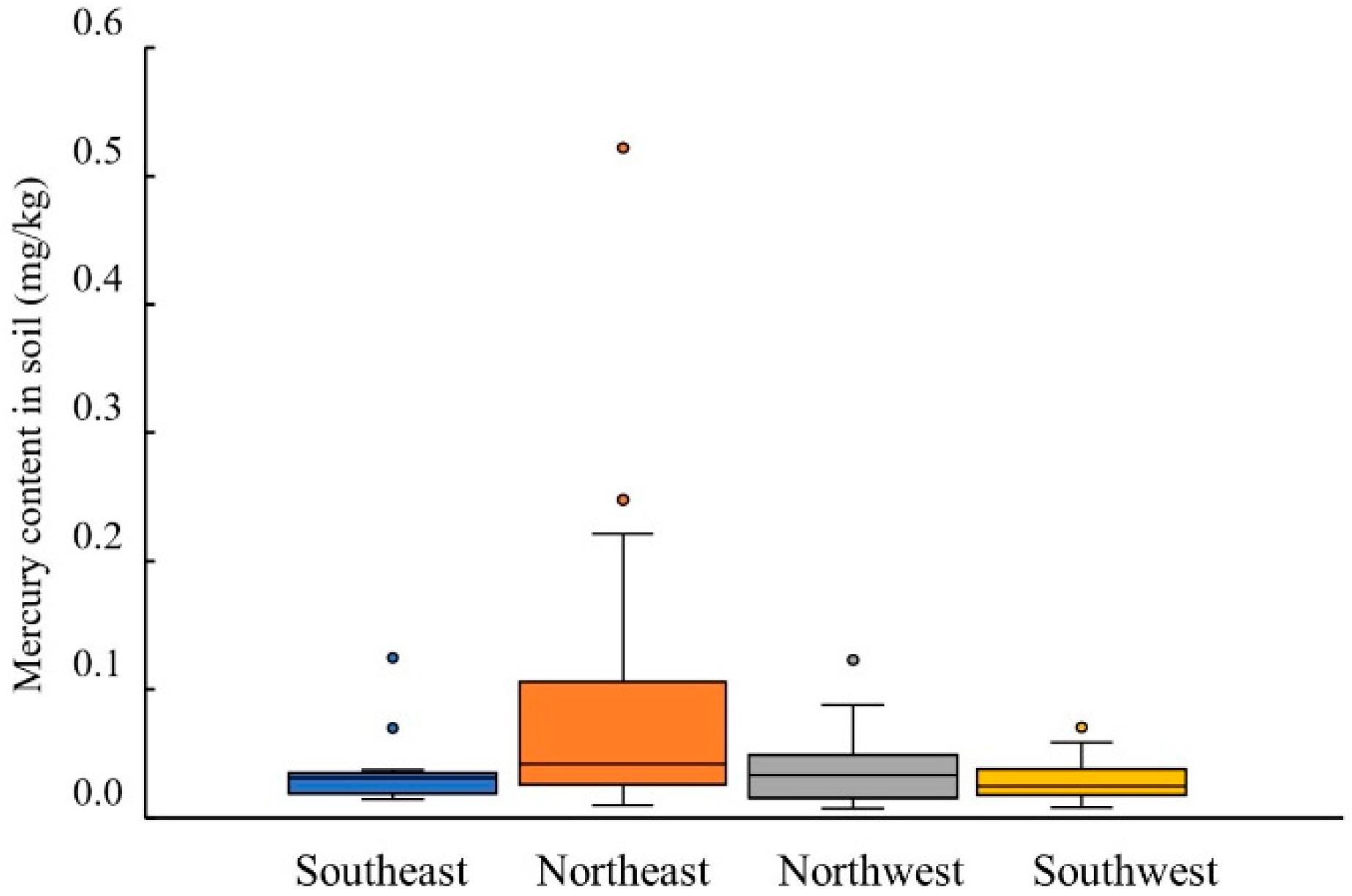

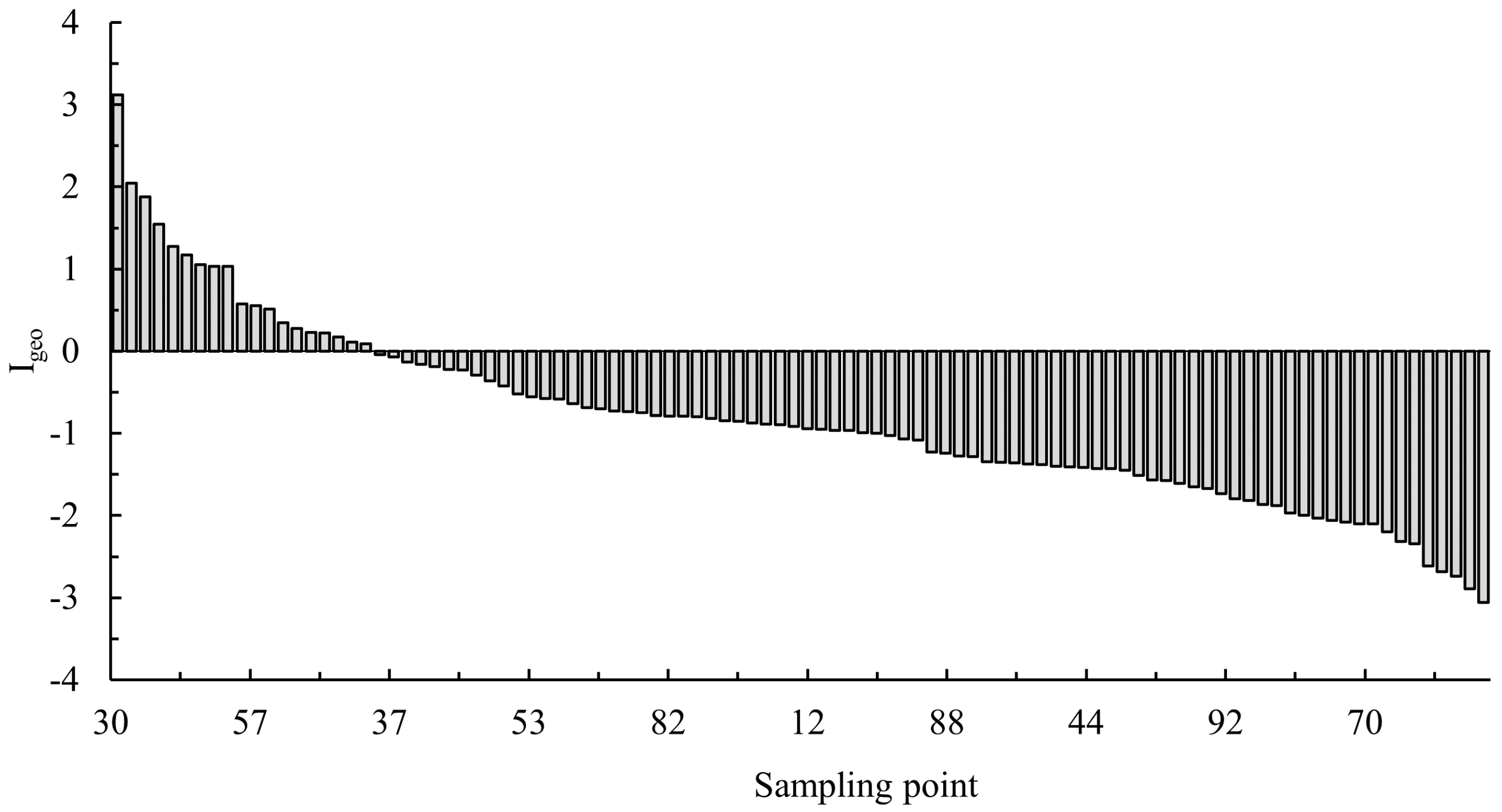
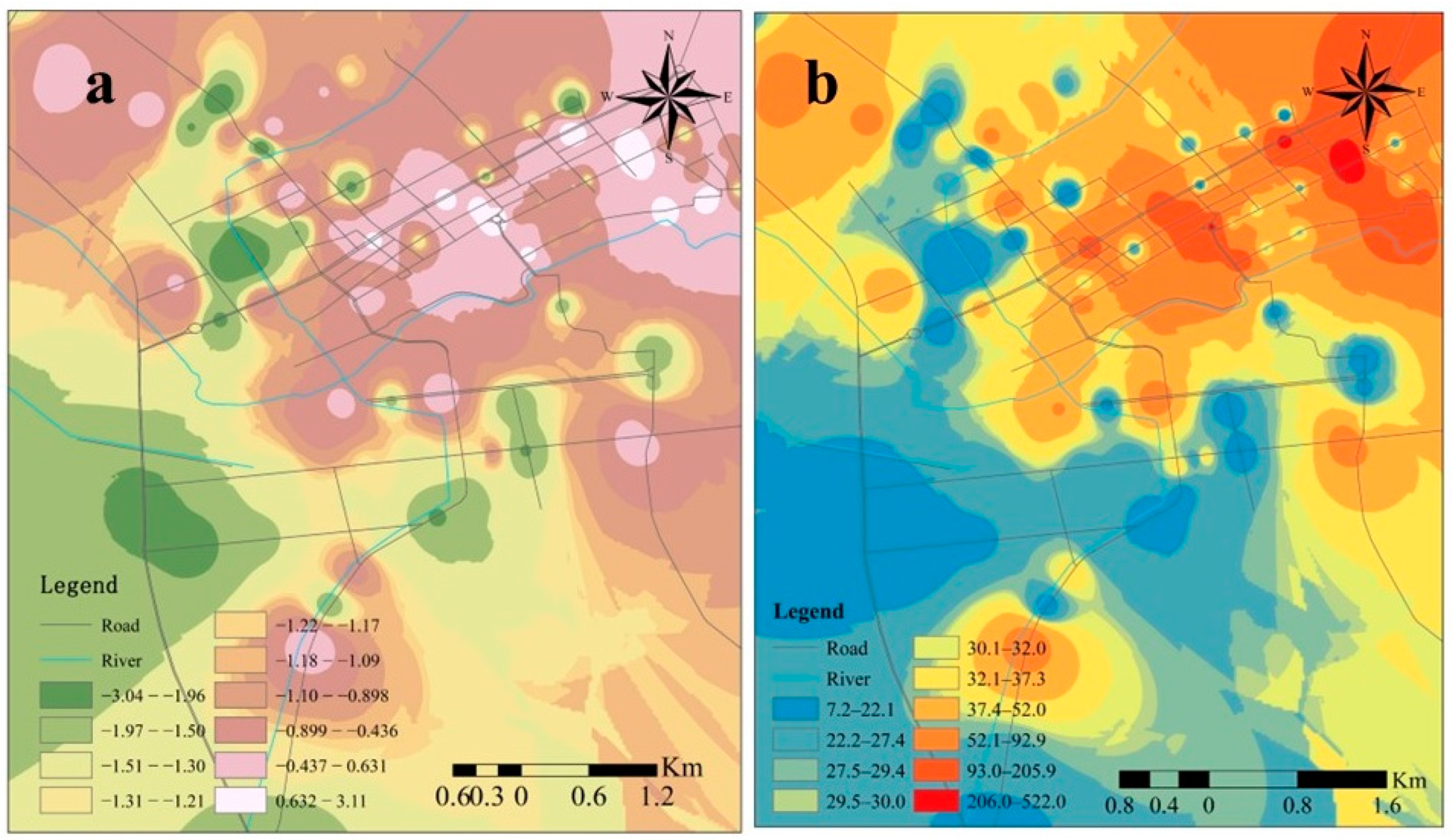


| Geo-Accumulation Index (Igeo) | Grading | Degree of Contamination |
|---|---|---|
| 5 < Igeo ≤ 10 | 6 | Extremely strong |
| 4 < Igeo ≤ 5 | 5 | Strong/extremely strong |
| 3 < Igeo ≤ 4 | 4 | Strong |
| 2 < Igeo ≤ 3 | 3 | Medium-strong |
| 1 < Igeo ≤ 2 | 2 | Medium |
| 0 < Igeo ≤ 1 | 1 | Slight/medium |
| Igeo ≤ 0 | 0 | Non-pollution |
| Er | <40 | 40–80 | 80–160 | 160–320 | >320 |
|---|---|---|---|---|---|
| Potential Ecological Risk Index | Slight | Medium | Strong | Very strong | Extremely strong |
| Region | Number of Soil Samples (n) | Average (mg·kg−1) | Range (mg·kg−1) | Standard Deviation (mg·kg−1) | Coefficient of Variation (%) |
|---|---|---|---|---|---|
| Southeast | 18 | 0.0358 | 0.0142–0.125 | 0.0266 | 0.742 |
| Northeast | 29 | 0.0837 | 0.00940–0.522 | 0.103 | 1.23 |
| Southwest | 26 | 0.0377 | 0.00720–0.123 | 0.0260 | 0.690 |
| Northwest | 27 | 0.0289 | 0.00810–0.0704 | 0.0156 | 0.539 |
| All Regions | 100 | 0.0484 | 0.00720–0.522 | 0.0633 | 1.30 |
| Town | Range (mg·kg−1) | Average (mg·kg−1) | Background (mg·kg−1) | Maximum Coal Yield (Mt·a−1) | Operating Time | Reference |
|---|---|---|---|---|---|---|
| Zaozhuang | - | 0.040 | 0.010 | 1.92 | 1880–now | [53] |
| Huangshi (Yuancang Coal Mine) | 0.012~1.823 | 0.137 | 0.041 | 0.600 | 1949–2014 | [54] |
| Huaibei (Daihe Coal Mine) | 0.008~0.154 | 0.067 | 0.014 | 1.40 | 1965–2017 | [55] |
| Xiaoyi (Gaoyang Coal Mine) | 0.073~0.100 | 0.087 | 0.025 | 6.00 | 1965–now | [56] |
| Fushun (Longfeng Coal Mine) | N.D~0.646 | 0.102 | 0.037 | 1.02 | 1907–1999 | [57] |
| Jiutai District (Yingcheng Coal Mine) | 0.007~0.522 | 0.048 | 0.040 | 1.97 | 1880–2001 | This study |
| Rohini OCP, NK Area, India | - | 0.090 | 0.050 | 3.00 | 2007–now | [17] |
| Pszczyna County, Poland | 0.020~0.460 | 0.070 | 0.010 | 2.00 | 1792–now | [29] |
| Ostrava, Czech Republic | 0.080~1.310 | - | 0.070 | 9.00 | 1830–now | [30] |
Publisher’s Note: MDPI stays neutral with regard to jurisdictional claims in published maps and institutional affiliations. |
© 2022 by the authors. Licensee MDPI, Basel, Switzerland. This article is an open access article distributed under the terms and conditions of the Creative Commons Attribution (CC BY) license (https://creativecommons.org/licenses/by/4.0/).
Share and Cite
Xiao, Y.; Zhang, G.; Guo, J.; Zhang, Z.; Wang, H.; Wang, Y.; Wang, Z.; Yuan, H.; Cui, D. Pollution Characteristics and Risk Assessments of Mercury in Jiutai, a County Region Thriving on Coal Mining in Northeastern China. Sustainability 2022, 14, 10366. https://doi.org/10.3390/su141610366
Xiao Y, Zhang G, Guo J, Zhang Z, Wang H, Wang Y, Wang Z, Yuan H, Cui D. Pollution Characteristics and Risk Assessments of Mercury in Jiutai, a County Region Thriving on Coal Mining in Northeastern China. Sustainability. 2022; 14(16):10366. https://doi.org/10.3390/su141610366
Chicago/Turabian StyleXiao, Yuliang, Gang Zhang, Jiaxu Guo, Zhe Zhang, Hongyi Wang, Yang Wang, Zhaojun Wang, Hailong Yuan, and Dan Cui. 2022. "Pollution Characteristics and Risk Assessments of Mercury in Jiutai, a County Region Thriving on Coal Mining in Northeastern China" Sustainability 14, no. 16: 10366. https://doi.org/10.3390/su141610366
APA StyleXiao, Y., Zhang, G., Guo, J., Zhang, Z., Wang, H., Wang, Y., Wang, Z., Yuan, H., & Cui, D. (2022). Pollution Characteristics and Risk Assessments of Mercury in Jiutai, a County Region Thriving on Coal Mining in Northeastern China. Sustainability, 14(16), 10366. https://doi.org/10.3390/su141610366






